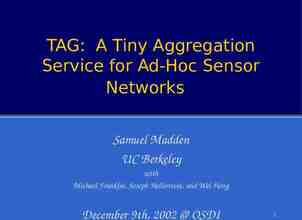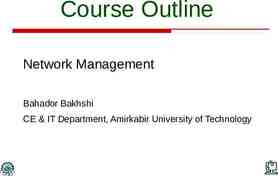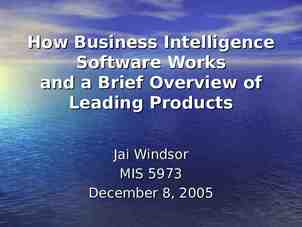Cognitive Views of Learning Cluster 7 The Cognitive Perspective
17 Slides135.00 KB
Cognitive Views of Learning Cluster 7 The Cognitive Perspective Information Processing Metacognition Becoming Knowledgeable
The Cognitive View of Learning: A general approach that views learning as an active mental process of acquiring, remembering and using knowledge. Knowledge guides new learning and knowledge is the outcome of learning. Assumptions about the cognitive perspective: Knowledge is learned, and changes in knowledge make changes in behavior possible Reinforcement is seen as a source of feedback about what is likely to happen if behaviors are repeated. Feedback is a source of information People are seen as active learners who initiate experiences, seek out information to solve problems, and reorganize what they already know to achieve new insights New cognitive approaches stress the construction of knowledge Already acquired knowledge determines to a large extent what we will pay attention to, perceive, learn, remember, and forget in the future
Comparing Perspectives Differ in their assumptions about learning and in their methods Behavioral Psych Cognitive Psych Behaviors Knowledge Reinforcement strengthens behavior Learners respond to environmental stimuli Knowledge is acquired Reinforcement is a source of feedback Learners initiate learning experiences Knowledge is constructed Study done on animals Study done on animals and people
Types of Knowledge General-Information that is useful in many different kinds of tasks; information that applies to many situations Domain Specific- Information that is useful is a particular situation or that generally applies to only one specific topic No absolute line between general and domain specific knowledge Declarative-Verbal information facts. Knowing that something is the case, specific facts, personal preferences, personal events, rules Procedural-Knowledge that is demonstrated when we perform a task. Knowing how to do something Conditional General numbers or structural-Reading, Knowing when and why to apply declarative and procedural knowledge Domain specific Periodic table Declarative: Who, what, where? Procedural: How? History dates Names of presidents Riding a bike Conditional: Why? Which study strategy should I use?
Memory Human mind’s activity of taking in, storing, and using information Encoding gathering and representing information process by which information gets into memory Storage holding information Retrieval getting the information when needed Control Processes guides how and when information will flow through the system
Sensory Memory Use of the 5 senses Holds sensations from the environment for a brief time in their original form Very large capacity Because of its short duration, it is important for students to attend to sensory information that is important for learning Perception The meaning we attribute to sensory memory Heavily influenced by what we already know-example lead vs. lead Gestalt (pattern/configuration) Theory- organized meaningful wholes vs. bits and pieces Bottom-Up processing- a.k.a. feature analysis- stimulus is analyzed into features or components and assembled into a meaningful pattern Top-Down Processing- Based on knowledge and expectations Attention sensory memory for up to several seconds visual images about ¼ of a second limited resource can only pay attention to one demanding task at a time Automaticity ability to process information with little or no effort perform thoroughly learned tasks without much effort
Working Memory a.k.a. Short Term Memory See Figure 18.3, p. 236 Holds the information that is currently activated Capacity: Limited, 5-9 separate new items at once Duration: Short, about 5-20 seconds (without maintenance rehearsal) Contents: May be in the form of images or structured more abstractly and based on meaning Structure: Central Executive-”Supervisor.” integrates information from the two below, and long term memory as well. Transfers information to the long term memory via strategies such as rehearsing. Plays important roles in attention, planning, and organizing behavior. Phonological Loop-Memory rehearsal system specialized to briefly store speech-based information. Limited capacity Visuospatial Sketchpad-Stores visual and spatial imagery. Can work with the phonological loop—rehearse numbers in phonological group while using visual spatial memory. Limited capacity.
Retaining Information in Working Memory Rehearsal can increase duration –Maintenance rehearsal –Elaborative rehearsal –Chunking Forgetting – Interference –Decay
Comparison of Short- & Long Term Memory Short Term Very fast input Limited capacity 5–20 seconds duration Contains words, images, ideas, sentences Immediate retrieval Long Term Relatively slow input Practically unlimited capacity Practically unlimited duration Contains networks, schemata Retrieval depends on connections
Teaching Hold information that is well learned Capacity: Unlimited Duration: Can remain in long-term memory indefinitely Access can be difficult Dual Coding Theory (Alan Paivio): Information is stored as either visual images or verbal units, or both Information coded both ways may be easier to learn See Figure 19.1, p. 242 Declarative-Explicit-Long term memories. Conscious recollection of information—specific facts, events that can be verbally communicated. Deliberate recall. Procedural-Implicit-Knowledge that we are not conscious of recalling in the form of specific events. Knowledge in the form of skills and cognitive operations.
Types of Memory Episodic Yesterday’s golf outing Semantic The concept airplane Procedural How to give a presentation
Explicit Memories Semantic Memory-memory for meaning Stored as propositions, schemas and images Propositions & propositional networks Images are representations based on perceptions— perception of the appearance of information Schema are abstract knowledge structures proposition-smallest unit of information that can be judged propositional network-interconnected bits if information Bits of information can trigger or activate recall of another “proposition” organize a vast amount of information patterns or guides for understanding an event, concept, or a skill Story grammar Event schema/script Episodic memory is memory for information tied to a particular place and time, especially events in one'
Implicit Memories -Procedural Knowledge in the form of skills and cognitive operations Mental and motor skills are stored as procedural knowledge musician’s ability to play a song athletes to perform in an event driving a car Knowledge that we are not conscious of recalling, but given the correct conditions, an action is triggered LTM Storage Strategies Elaboration-the addition of meaning to new information through its connection with already existing information Organization-material that is well organized is easier to learn and to remember than bits of information Context-aspects of physical and emotional content are learned along with other information Serial Position Effect-recall is better for items at the beginning and end of a list
Retrieval & Forgetting Levels of Processing Theories-the more completely information is processed, the better are the chances of retrieving the information later. Cues Spread of activation-retrieving of information based on relatedness to other information Reconstruction Decay Interference See Guidelines, Woolfolk p. 249
Metacognitive Knowledge Awareness of your own thinking processes Knowing what you know (declarative knowledge) Knowing how to use what you know (procedural knowledge) Knowing when and why to use what you know (conditional knowledge) Planning Monitoring Evaluation Differences in Metacognition and Memory Individual due Differences in Metacognition to development age/maturation biological differences variations in learning experiences
Learning Declarative Knowledge Making it meaningful Mnemonics Rote memorization Serial position effect Part learning Distributed practice Massed practice Mnemonics Loci method Peg type: keyword, peg word, acronyms Chaining Key Word Method Rote Memorization Making It Meaningful Relating to previous knowledge Relating to students’ experiences Clarifying unfamiliar terms Give examples, illustrations, analogies from students’ view Use humor, emotion, novelty
Procedural & Conditional Knowledge Automated basic skills Cognitive stage- rely on declarative knowledge and general problem-solving strategies Associative stage- individual steps of a procedure are combined into larger units Autonomous stage- whole procedure can be accomplished without much attention Prerequisite knowledge Practice with feedback-teachers can help students become experts through constructive feedback and practice Domain-specific strategies- consciously applied skills to reach goals in a particular subject, task or problem area






















